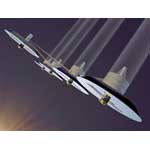Backyard Telescopes for New Planets. Is it Possible?
 Fifteen years ago, the largest telescopes in the world had yet to locate a planet orbiting another star. Today telescopes no larger than those available in department stores are proving capable of spotting previously unknown worlds. A newfound planet detected by a small, 4-inch-diameter telescope demonstrates that we are at the cusp of a new age of planet discovery. Soon, new worlds may be located at an accelerating pace, bringing the detection of the first Earth-sized world one step closer. This is the first extrasolar planet discovery made by a dedicated survey of many thousands of relatively bright stars in large regions of the sky. It was made using the Trans-Atlantic Exoplanet Survey (TrES), a network of small, relatively inexpensive telescopes designed to look specifically for planets orbiting bright stars. A team of scientists co-led by Edward Dunham of Lowell Observatory, Timothy Brown of NCAR, and David Charbonneau (CfA), developed the TrES network.
Fifteen years ago, the largest telescopes in the world had yet to locate a planet orbiting another star. Today telescopes no larger than those available in department stores are proving capable of spotting previously unknown worlds. A newfound planet detected by a small, 4-inch-diameter telescope demonstrates that we are at the cusp of a new age of planet discovery. Soon, new worlds may be located at an accelerating pace, bringing the detection of the first Earth-sized world one step closer. This is the first extrasolar planet discovery made by a dedicated survey of many thousands of relatively bright stars in large regions of the sky. It was made using the Trans-Atlantic Exoplanet Survey (TrES), a network of small, relatively inexpensive telescopes designed to look specifically for planets orbiting bright stars. A team of scientists co-led by Edward Dunham of Lowell Observatory, Timothy Brown of NCAR, and David Charbonneau (CfA), developed the TrES network.
The network's telescopes are located in Palomar Observatory (California, USA), Lowell Observatory (Arizona, USA), and the Canary Islands (Spain). Although the small telescopes of the TrES network made the initial discovery, follow-up observations at other facilities were required. Observations at the W. M. Keck Observatory which operates the world's two largest telescopes in Hawaii for the University of California, Caltech, and NASA, were particularly crucial in confirming the planet's existence. The newfound planet is a Jupiter-sized gas giant orbiting a star located about 500 light years from the Earth in the constellation Lyra. This world circles its star every 3.03 days at a distance of only 4 million miles (6 million kilometers), much closer and faster than the planet Mercury in our solar system.
Although such planets are relatively common, astronomers used an uncommon technique to discover it. This world was found by the 'transit method,' which looks for a dip in a star's brightness when a planet crosses directly in front of the star and casts a shadow. A Jupiter-sized planet blocks only about 1/100th of the light from a Sun-like star, but that is enough to make it detectable. To be successful, transit searches must examine many stars because we only see a transit if a planetary system is located nearly edge-on to our line of sight. A number of different transit searches currently are underway. Most examine limited areas of the sky and focus on fainter stars because they are more common, thereby increasing the chances of finding a transiting system. However the TrES network concentrates on searching brighter stars in larger swaths of the sky because planets orbiting bright stars are easier to study directly.
Fact Credit
NASA Headquarters


